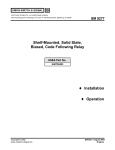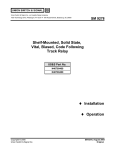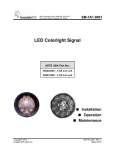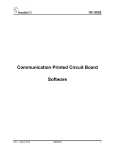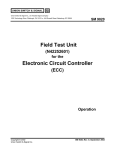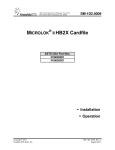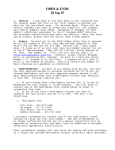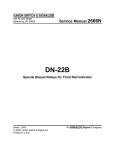Download FN-16 and FN-16A - QuebecTrain.com
Transcript
UNION SWITCH & SIGNAL 645 Russell Street Service Manual 3151 Batesburg, SC 29006 FN-16 and FN-16A Flasher Relays Installation, Operation, and Maintenance April, 1997 C-1/84-75-356-5 COPYRIGHT 1997, UNION SWITCH & SIGNAL INC. PRINTED IN USA An Ansaldo Signal Company SM 3151 FN-16 and FN-16A Flasher Relays 2 SM 3151 FN-16 and FN-16A FLASHER RELAY ********************************* This service manual covers information for shop repair adjustment and calibration of FN16 and FN -16A Flasher Relays with 2N-2R (now obsolete) and 4N-4R contacts. The FN-16A differs from the FN-16 relay only in design of the lamp contacts, which necessitates the use of a heavier armature counterweight, and in that the armature supporting bracket is arranged to permit the armature to be assembled to the relay without removing the contact springs from the armature. The lamp contacts on the FN-16 relay were designed only for AC loads while the lamp contacts on the FN-16A relay may be used for DC as well as AC lamp load. The operating coils are equipped with a rectifier for suppression of radio interference originating in the self-operating contacts. The operating mechanism is designed to provide minimum wear at the armature pivots and core pins, thus assuring that the rate of contact operation (i.e. flashing rate) remains above the AAR minimum value without any need of adjustment for many millions of operations. Original timing can readily restored in the field, when required, by removing one or more copper washers from the common core. The core and coil assembly is so constructed that timing adjustments can be made without unsealing the relay or disturbing the relay adjustments. All new and re-manufactured flasher relays have a minimum of six (6) copper washers to allow for this field adjustments. The flash rate on the FN-16 and FN-16A is 45-55 operations per minute. Prior to 1979 the flash rate was 40-45. The minimum flash was increase by AAR at that time. 1. OILING OF BUSHING HOLES AND PIVOTS For oiling trunnion screw pivots and bushings in the armature, we recommend Special Instrument Oil, US&S part number J-041099. When using this oil the cap is turned carefully until free, and then with-drawing the applicator rod, the rod shall be draw slowly across the edge of the bottle opening to remove any excess oil. This rod shall be returned to the bottle without coming in contact with any foreign material. It shall be wiped clean each time that there is suspicion of contamination, and the bottle be closed promptly within its own cap. IT IS VERY IMPORTANT THAT THE OILING BE PERFORMED AS FOLLOWS: A. The bushing holes in the armature shall be carefully examined to check that they perfectly clean and free from dust. B. The bearing area of the pivot screws shall be thoroughly covered with oil by means of the rod, the rod being withdrawn from the bottle in such a manner as to leave a drop of oil on it. Since this non-spreading oil it FN-16 and FN-16A Flasher Relays 3 SM 3151 should be placed directly on the surface to lubricated. After the oil drop has been applied, the applicator rod should be wiped against the edge of the bottle opening to remove the surplus drops. The rod should then be used to distribute the drop of oil over the bearing area of the pivot screws. Any excess oil on the pivots shall be removed by just touching it with a lintless cloth. Care should be taken not to cover the should not threaded portion of the screws with oil. C. Care shall be taken that the oiled parts are protected from dust from the time of oiling until the relay is sealed. 2. ARMATURE A. The armature should be located centrally in the bracket; i.e. the distance from the side of armature to the bracket should be the same at the front of the relay as it is at the back, making allowance for the end play specified in (2B). B. The end play of the armature should be not less than .010 in. nor more than .015 in. C. The pivot screws should be tightened securely to bracket, and after the armature air gap is set, the armature bracket should be tightened securely to the central pole piece, and the hex head nuts and bolts locked with the lock washers. D. The air gap in either extreme position should be set as closely as possible to a parallel value of .015 in. At no point should the air gap be less than .013 or no more than .017 in. E. The armature stop pins should strike as flatly as possible against the pole faces. F. The total stroke of the armature should be checked to see that it is .106 in. +/- .002 in. A convenient means for checking this is to use two separate spacers .053 in. thick placed one between each stop pin and pole face and at the inside edge of the stop pin. 3. CONTACT ADJUSTMENTS A. Before the contacts are adjusted, all screws holding contact supports and contact members should be checked for tightness. A check of the lamp control contact springs with wedge and flat tips and the relay control springs with spherical faced tips should also be to see that they occupy their correct relative position as shown in figures 1, 2 and 3. Spacer used FN-16 and FN-16A Flasher Relays 4 SM 3151 under the armature stop pin during contact adjustment are to be held firmly by pressure applied to the armature between the stop and the pivots so as to bring the armature as close to the pole faces as play in the pivots will permit. B. FN-16A relay lamp contacts shall be adjusted with a .028 in. spacer under the stop pin on the opposite side of the relay. That is, the right-handed lamp contacts are adjusted by means of a spacer on the left-hand side, and visa versa. With this spacer the upper and lower tips shall be in line and light barely perceptible between contact points. A .001 in. thinner spacer shall allow the contacts to close. If necessary in order to obtain flasher frequency it is permissible to adjust the contacts to just open with a .025 in. spacer and to close with a .024 in. spacer. The contact springs and their stops shall be adjusted so that the springs have an initial pressure against the stops of 16 to 25 grams on the 4N-4R contact relays and 30 to 32 grams on 2N-2R contact relays. The pressure shall be measured at the tip[s in a direction perpendicular to the spring at the tips. The stop shall be adjusted with its end as close as possible to the contact tips without interfering with the normal movement of the contact spring. The lamp contacts (with wedge to flat tips) shall make over at least 25% of the contact line contact. The minimum contact opening with contacts just making on the other side shall not be less than .058 in. FN-16 and FN-16A Flasher Relays 5 SM 3151 C. FN-16 relay lamp contacts should be adjusted with a .036 in. spacer under the stop pin on the opposite side of the relay. That is the right-hand lamp contacts are adjusted by means of a spacer at the left-hand stop pin and visa-versa. With this spacer the upper and lower contact tips should be in line, and the light should barely be perceptible between the contact points. A .001 in. thinner spacer should allow the contacts to close. The minimum contact opening on the one side with the contacts just making on the other side should not be less than .020 in. D. Operating contacts (FN-16 and FN-16A relays) should be adjusted with a .041 in. spacer between the armature stop pin and the pole face on the left side of the relay (as viewed from the front with the relay in the normal position). The left operating contact should be adjusted so that light is barely perceptible between the contact points and .040 in. spacer should allow the contacts to close. After adjusting the left operating contact, the right operating contact should be adjusted so that light is barely perceptible between the contact points with a .060 in. spacer under the left stop pin. A .061 in. spacer should the allow the right operating contact to FN-16 and FN-16A Flasher Relays 6 SM 3151 close. This adjustment provides for .020 in. contact opening with either operating contact just making. E. The flexible connectors should be dressed so that on the operation of the armature there is no concentrated bending at any point, especially near soldered ends. The flexing should be distributed as much as possible over the whole length of the connectors. The flexible connectors shall not touch the cover during operation after it is installed. 4. CONTACT RESISTANCE A. The contact resistance shall be measured on all contacts, with armature against the stop pin . Resistance measured shall not exceed the values given in the following table: Contact surfaces Silver to silver impregnated carbons Silver to silver Ohms .05 .03 5. BACK STRAP The back strap and tops of the cores should be clean and make good magnetic contact. 6. TIME PERIOD ADJUSTMENT A. After the contacts have been adjusted, the adjustment to obtain exact timing shall be made as follows: B. Apply voltage as specified in table under “Timing Test Volts” for the proper relay resistance to the coil terminals of the relay. Connect an “on time meter” (Simpson TS-111 or equivalent) to the right hand lamp contact and while relay is operating note the time of the closed circuit. Then repeat the same test on a left hand lamp contact and compare the readings. If the two time periods, i.e. armature movements, are not within +/- 20%, adjust the air gap by moving the adjustable shunt by increasing or decreasing the air gap between the shunt and the central pole piece to obtain proper balance. C. Next count the number of operations per minute. Armature operations shall be counted in cycles, i.e. a left and right operation as one operation. Thus operations counted are the same as “Flashes per lamp per minute”. D. Adjust the timing to meet the requirements in Table under “Shop Adjustments”. FN-16 and FN-16A Flasher Relays 7 SM 3151 If necessary, copper washers on the common core may be removed or added for specified flash rate. In no case shall the number of washers on the common core be less than 6 after proper timing is obtained. A maximum of 29 washers may be used if required. NOTE: Original timing can be restored in the field, when required, by removing copper washers from the common core. In order to maintain the minimum required flash rate it is permissible to have less than 6 washers. However, when it becomes necessary to remove these washers indicating wear, it is recommended the relay be shopped. Union Switch & Signal recommends no less than three washers to maintain minimum flash rate. 7. MINIMUM OPERATING VOLTAGE After the timing adjustments, check that the relay starts to operate at the minimum operating voltage for the proper relay resistance as given in Table 1. 8. CLEANING A. During Adjustment and Calibration extreme care should be taken to see that no foreign matter is carried to the assembly by tools or spacers. After adjustment is completed, the stop pins shall be cleaned by drawing a strip of clean white bond paper between the stops and the pole faces. Spacers shall not be used between the stop pins after final cleaning with paper. B. Before Sealing the Relay a careful inspection shall be to insure removal of all dirt and loose particles from the inside of the relay. FN-16 and FN-16A Flasher Relays 8 SM 3151 TABLE I Shop Adjustment Relay Resistance Ohms 4.5-4.5 200-200 500-500 Normal Operating Volts 1.0-1.2 6.8-8.0 10.0-12.0 FN-16 and FN-16A Flasher Relays Minimum Operating Volts 0.9 6.0 8.5 Flashes Per Lamp Per Min. 48-55 48-55 48-55 Timing Test Volts 1.1 7.0 11.0 Nominal Rating Flashes Per Lamp Per Min. 45-55 45-55 45-55 9 SM 3151 FN-16 and FN-16A Flasher Relays 10 SM 3151 FN-16 and FN-16A Flasher Relays 2











